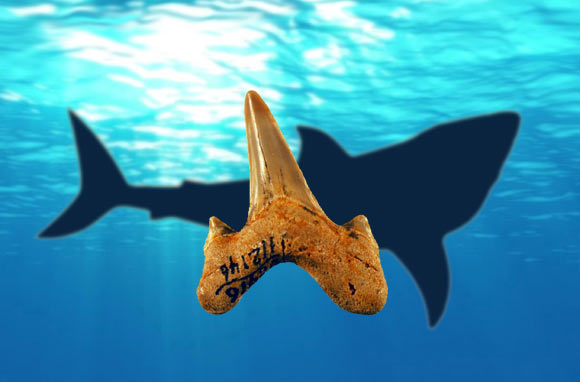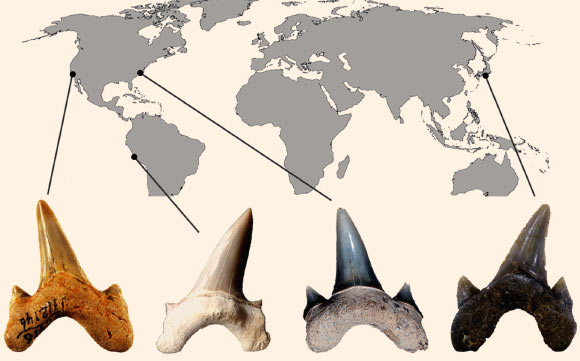Fossilized teeth from a newly identified species of extinct shark that lived 20 million years ago (early Miocene) were found in the mid-latitudinal zones along the Pacific (Japan, California, and Peru) and western Atlantic (North Carolina) coasts.

Megalolamna paradoxodon lived in the same oceans megatoothed sharks inhabited. Image credit: Kenshu Shimada / DePaul Univedrsity.
The new fossil shark, named Megalolamna paradoxodon, belongs to a group called Lamniformes, which includes modern-day great white (Carcharodon carcharias) and mako (Isurus spp.) sharks.
“More specifically, it belongs to Otodontidae, which contains the extinct Carcharocles megalodon, or the ‘megatoothed’ shark, and as an otodontid, Megalolamna paradoxodon represents a close cousin of the megatoothed lineage,” said Dr. Kenshu Shimada of DePaul University and the Sternberg Museum in Kansas.
The paper describing Megalolamna paradoxodon was published online today in the journal Historical Biology, and was also contributed to by researchers at the University of Hong Kong, the Natural History Museum, London and North Carolina State University.
“Certain dental features suggest its otodontid affinity, but in many other aspects, teeth of the new fossil shark look superficially like over-sized teeth of the modern-day salmon shark that belongs to the genus Lamna — hence the new genus Megalolamna,” the authors said.
Megalolamna paradoxodon were as long as 13 feet (4 m) from snout to tail and lived in shallow-water, shelf-type, coastal environments.
The species had grasping-type front teeth and cutting-type rear teeth (up to 1.8 inches, or 4.5 cm, tall) likely used to seize and slice medium-sized fish.
“It’s quite remarkable that such a large lamniform shark with such a global distribution had evaded recognition until now, especially because there are numerous Miocene localities where fossil shark teeth are well sampled,” Dr. Shimada said.
In classifying the ancient marine creature, Dr. Shimada and co-authors also came to a conclusion that members of the megatoothed lineage, including Carcharocles megalodon, ought to be classified into the genus Otodus, and not to its traditional genus Carcharocles.
“The idea that megalodon and its close allies should be placed in Otodus is not new, but our study is the first of its kind that logically demonstrates the taxonomic proposition,” Dr. Shimada said.
“Because the megatoothed shark lineage simply represents a subset of Otodus, excluding megatoothed sharks would not reflect a full lineage for Otodus — an uncomfortable taxonomic condition referred to as non-monophyletic.”
“The inclusion of megatoothed sharks into Otodus would make the genus a much preferred complete lineage referred to as a ‘monophyletic group’ that is considered to be a next of kin to the new genus Megalolamna.”
_____
Kenshu Shimada et al. A new elusive otodontid shark (Lamniformes: Otodontidae) from the lower Miocene, and comments on the taxonomy of otodontid genera, including the ‘megatoothed’ clade. Historical Biology, published online October 3, 2016; doi: 10.1080/08912963.2016.1236795








